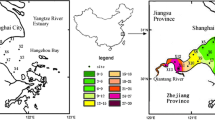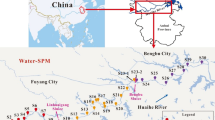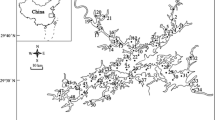Abstract
Residual levels, distribution and possible sources of organochlorine pesticides (OCPs) in nine water column and suspended particulate matter (SPM) samples collected from Xiangshan Bay, East China Sea were investigated. Total OCPs concentrations in water column and SPM ranges from 2.88 to 34.72 ng/L and 2.47 to 29.94 ng/L, respectively, which exceed the US Environmental Protection Agency regulatory limits. Moreover, low ratio of α-HCH/γ-HCH and high ratios β- and γ-HCH suggested the cocktail input pattern of fresh and weathered HCHs. Meanwhile, low ratio of (DDE + DDD)/DDT and high ratios p,p′- and o,p′-DDT reflected a “dicofol type DDT pollution” pattern.
Similar content being viewed by others
Explore related subjects
Discover the latest articles, news and stories from top researchers in related subjects.Avoid common mistakes on your manuscript.
Organochlorine pesticides (OCPs), such as hexachlorocyclohexanes (HCHs), and dichlorodiphenyltrichloroethanes (DDTs) are typical persistent organic pollutants, which have been of increasing concerns across the world due to their salient feature of environmental persistence (Zhang et al. 2007), trend in bioaccumulation (Woodwell et al. 1971), and adverse effects on humans and other animals (Willett et al. 1998). These pesticides are considered to act as endocrine-disrupting chemicals, which pose great threats to the health of ecosystem. Being one of the countries with the largest agricultural production, China has been a large producer and consumer of OCPs in the world. The production of HCHs and DDTs in China were 4.9 million tons and 0.4 million tons, accounting for 33 % and 20 % of the total world production, respectively (Zhang et al. 2002). Even after the ban of technical HCH and DDT in 1983, lindane (contains above 99 % γ-HCH) and dicofol (contains about 15 % DDTs) can still be produced and adopted for malaria control and domestic use (Qiu et al. 2005).
Xiangshan Bay, the long and narrow bay located in the east coast of Zhejiang province, is an important aquafarm and sea-route. Historically, Zhejiang province is one of the areas where pesticides were heavily used, it has been estimated that the total consumption in Zhejiang province was more than 300,000 tonnes from 1952 to 1984 which accounted for about one tenth of China’s total OCPs application. These contaminants may enter the Xiangshan Bay through surface runoff, creating long-term adverse effects on coastal resources. However, no data is available on the levels of such compounds in water and (suspended particulate matter) SPM of Xiangshan Bay, yet such information is essential for assessing the environmental quality of the Bay, for minimizing any adverse effects to the aquatic organisms and for preventing human risk from the consumption of seafood. Therefore, the objective of this study are (1) to provide a complete mapping of OCPs distributions in water and SPM of the Xiangshan Bay; (2) to elucidate contamination profiles and potential input sources of OCPs.
Materials and Methods
A total of 27 water samples were collected in individual 4.5 L pre-cleaned glass bottles at three different depths, i.e., surface (0.5 m), middle and bottom (0.5 m from the bed). The locations of these sampling sites in the selected area are shown in Fig. 1. After returning to the laboratory, the SPM were collected by filtering water sample through the glass microfiber filters (Whatman GF/F, 0.47 um effective pore sizes). Then the GF/F filters were wrapped with aluminum foil, stored at −20°C until analysis. The filtered water was then passed through a mixture resin (XAD-2 and XAD-4 1:1 mixtures) glass column to retain the dissolved organics.
The procedures for eluting dissolved organics from XAD resins and for processing glass fiber filters have been described elsewhere (Luo et al. 2004). Briefly, each XAD resin column was spiked with surrogate standards (PCB209 and TCmX), and extracted with methylene chloride and methanol in an ultrasonic bath three times. Anhydrous Na2SO4 were used to remove any residual water. Particle-loaded filters were weighed after being frozen-dried and were spiked with surrogate standards and extracted in a Soxhlet apparatus with methylene chloride for 24 h. Activated copper was also added for desulfurization. The extract was concentrated and further solvent-exchanged to hexane. Concentrated extracts were cleaned up using a 1:2 alumina:silica gel glass column. The column was eluted with 70 mL of methylene chloride/hexane (30:70) and then concentrated up to 0.5 mL for GC injection.
Organochlorine pesticides were quantitatively analyzed using a HP-6890 gas chromatograph equipped with a 63Ni electron capture detector, and an HP-5 capillary column. The column temperature was initial set at 60°C, increased at 10°C min−1 to 220°C, and further ramped to 280°C at 5°C min−1 to hold 20 min; injector and detector temperature were set at 250 and 300°C, respectively. The levels of OCPs were quantitatively determined by the internal standard methods using peak area of composite standards. For every set of fifteen samples, a procedural blank and a spiked blank were used to check interferences and circumvent cross-contaminations. No significant peaks overlapping those of OCP standards appeared in the chromatograms of the procedural blanks. The method detection limits (MDL) of OCPs was defined as the concentration of standard that could produce a chromatographic peak with signal/noise ratio of 3, and the MDL values were from 0.011 to 0.236 ng g−1 for target compounds. The spiked recoveries of OCPs were in the range of 76.7 %–94.8 % and 80.3 %–95.1 % in the water and SPM, respectively. The recoveries for TCmX and PCB 209 were in a range of 77.3 %–95.8 %, 77.6 %–93.7 % and 83.2 %–105.1 %, 80.0 %–96.7 % in the water and SPM, respectively. All samples were extracted and analyzed in triplicate.
Results and Discussion
Concentrations of 9 OCPs were detected in the water of the Xiangshan Bay, East China Sea (Table 1). Horizontal distributions of OCPs in water of Xiangshan Bay varied widely for different sampling locations. The highest OCPs concentration was detected at the site X2, followed by sites of X3, X4 and X1. The reason may be (1): all the sites were located in the inside of the Xiangshan Bay where the discharge pollutants are hard to be transported to the open sea; (2): the sites near the traditional agricultural regions where OCPs have been used extensively. In contrast, the water flow and current velocity may play an important role of the OCPs contamination in the region, the OCPs levels were sharply decreased through sites X7, X8 and X9, which located in the outer part of the Xiangshan Bay. More interesting results were found that concentrations in surface and bottom water were higher than middle water of both HCHs and DDTs. Two reasons might explain the phenomena. Firstly, atmosphere deposition can increase the concentration of OCPs in the surface water; secondly, the sediments can be resuspended by large-scale atmospheric and oceanic movements, resulting in the contamination to the bottom water.
Average concentrations of total HCHs and total DDTs in water were 13.05 and 3.56 ng L−1, respectively. According to Chinese official guideline (GH 3838 2002), in grades 1 water that is considered to pose no hazard to the aquatic and human health, the concentration of HCHs should be less than 1,000 ng L−1, and DDTs less than 50 ng L−1. The present observation showed both DDTs and HCHs were lower than the guideline values. However, according to Environmental Protection Agency (EPA) quality guideline (EPA 822-Z-99-001 1999), the concentrations of the pesticides including α-HCH, p,p′-DDT, p,p′-DDE and p,p′-DDD exceed the EPA guideline values (<3.9 ng L−1 for α-HCH, less than 0.59 ng L−1 for p,p′-DDT and p,p′-DDE, and less than 0.83 ng L−1 for p,p′-DDD). Therefore, the potential health risks may exist to eco-systems and organism in Xiangshan Bay.
Composition variations of HCH isomers or DDT congeners in the environment can provide useful information on the pollution sources (Doong et al. 2002). Generally, technical-grade HCH consists principally of four isomers, α-HCH (55 %–80 %), β-HCH (5 %–14 %), γ-HCH (8 %–15 %), δ-HCH (2 %–16 %), while γ-HCH is above 99 % in lindane (Lee et al. 2001). The ratio of α-HCH/γ-HCH is 4.64–5.83 for industrial HCH, and 0 for lindane respectively. Lower α-HCH/γ-HCH ratio implied the presence of a possible sporadic emission source of lindane nearby these areas. As a result, the corresponding values of α-HCH/γ-HCH can be used to monitor whether the source is from the technical HCH or lindane. On the other hand, predominance of β-HCH could be used to explore sources from historical usage or fresh input (Law et al. 2001). That’s because β-HCH is most stable and relatively resistant to microbial degradation among the HCH isomers (Walker et al. 1999) and the isomers of α-HCH and γ-HCH can be transformed into β-HCH in the environment (Willett et al. 1998). In the paper, the low ratio of α-HCH/γ-HCH in the sampling sites suggested that the input of HCH is a mixture of HCH and lindane. Although the use of technical-HCH was banned in China since 1983, γ-HCH probably came from lindane, which still been produced and used for malaria and grasshopper control in eastern China. In addition, the average compositions of HCH isomers measured in the samples are: γ-HCH (39 %) > α-HCH (29 %) > β-HCH (23 %) > δ-HCH (9 %) in surface water, β-HCH (37 %) > γ-HCH (28 %) > α-HCH (24 %) > δ-HCH (11 %) and β-HCH (34 %) > γ-HCH (29 %) > α-HCH (24 %) > δ-HCH (13 %) in middle and bottom water, respectively. The predominant of γ-HCH in surface water reflects the recent use of lindane. And high percentage of β-HCH and γ-HCH in middle and bottom water implied that HCH residues derived mainly from the mixture of historical usage of technical HCH and recently usage of lindane. Comparing to the nerghbouring region, similar composition of HCH isomers in water sample were also found in Qiantang River (Zhou et al. 2008) and North South China Sea (Zhang et al. 2007).
The average composition of DDT isomers measured in the water samples were: p,p′-DDT (36 %), o,p′-DDT (23 %), p,p′-DDD (11 %), o,p′-DDD (13 %), p,p′-DDE (17 %), with the dominance of p,p′-DDT. Whereas, technical DDT contains 75 % p,p′-DDT, 15 % o,p′-DDT, 5 % p,p′-DDE, and <5 % others. The relative concentration of the parent DDT compound and its biological metabolites, DDD and DDE, can be used as indicative indices for assessing the possible pollution sources. Since DDT can be biodegraded under aerobic condition to DDE and under anaerobic condition to DDD in the environment (Bopp et al. 1982), the ratio of (DDE + DDD)/DDT can be used to evaluate if the DDT emission occurred recently or in the past. A ratios <0.5 indicate direct input of DDT and a ratios >0.5 reflect past usage (Doong et al. 2002). As shown in Table 1, ratios of (DDE + DDD)/DDT were in the range of 0.17–0.66 with 87 % of the values being <0.5 implying a recent input of DDT in Xiangshan Bay. Such high DDT fractions are indicators of recent input. Furthermore, higher o,p′-DDT and p,p′-DDT concentration in water samples in Xiangshan Bay showed the contribution of typical dicofol type DDT pollution. Since dicofol is still used for protecting fruit tree and cotton in some scattered sites along the river bank according to a recent investigation, DDT pollution in the water samples in Xiangshan Bay may come from mixture of dry/wet deposition, agricultural soil, and runoff from the land.
Detection rates of residues of HCHs and DDTs in SPM of Xiangshan Bay were up to 100 % (Table 1), indicating wide occurrence of these compounds in SPM from Xiangshan Bay. Peak value for the concentrations of OCPs was found at sample location X2, where a lower water depth may lead to more intensive sediment re-suspension process. Moreover, most of the sites (site X1, X2, X3, X4, X5 and X6) were located in the inner part of the bay and showed much higher levels than the sites (site X7, X8, and X9) located in the outer part. The concentration gradients indicated that the sources of the OCPs may have been from localised urban pollutant discharge and were not easily transported to the open sea.
Similar to the compositions of OCPs in water, HCHs and DDTs compositions in SPM were also measured. For the HCHs, Ratios of α-HCH/γ-HCH varied from 0.38 to 1.58, with an average of 0.99. These relatively lower ratios indicated that there could be a possible usage of lindane. In addition, β-HCH levels ranged from 0.67 to 3.61 ng L−1 and accounted for 24 %–53 % of total HCHs. Predominance of β-HCH in all SPM samples could be used to explore sources from historical usage. However, γ-HCH was found in many samples at high levels, additionally suggesting a new input recent. For the DDTs, the concentrations of DDT isomers and metabolites measured in the SPM samples in Xiangshan Bay decreased in the order of p,p′-DDT (mean 3.33 ng L−1) > o,p′-DDT (mean 2.42 ng L−1) > p,p′-DDE (mean 1.88 ng L−1) > o,p′-DDD (mean 1.02 ng L−1) > p,p′-DDD (mean 0.87 ng L−1) (Table 1), the dominance of p,p′-DDT and o,p′-DDT suggests that fresh input of environment DDT compounds in SPM in the study areas. Further assessment can be made by the ratio of (DDE + DDD)/DDT. It’s clear that the ratio of (DDE + DDD)/DDT were in the range of 0.19–0.59, which demonstrates that most of the DDTs in this locality have been introduced relatively recently, and hence have not yet degraded significantly.
References
Bopp RF, Simpson HJ, Trier RM, Kostyk N (1982) Chlorinated hydrocarbons and radionuclide chronologies in sediments of the Hudson River and Estuary, New York. Environ Sci Technol 16:666–676
Doong RA, Peng CK, Sun YC, Liao PL (2002) Composition and distribution of organochlorine pesticide residues in surface sediments from the Wu-Shi River estuary, Taiwan. Mar Pollut Bull 45:246–253
EPA 822-Z-99-001 (1999) US Environmental Protection Agency, Office of Water, Washington, DC
GB 3838-2002 (2002) Environmental quality standards for surface water, State Environmental Protection Administration
Law SA, Diamond ML, Helm PA, Jantunen LM, Alaee M (2001) Factors affecting the occurrence and enantiomeric degradation of hexachlorocyclohexane isomers in northern and temperate aquatic systems. Environ Toxicol Chem 20:2690–2698
Lee KT, Tanabe S, Koh CH (2001) Distribution of organochlorine pesticides in sediments from Kyeonggi Bay and nearby areas, Korea. Environ Pollut 114:207–213
Luo XJ, Mai BX, Yang QS, Fu JM, Sheng GY, Wang ZS (2004) Polycyclic aromatic hydrocarbons (PAHs) and organochlorine pesticides in water columns from the Pearl River and the Macao harbor in the Pearl River Delta in South China. Mar Pollut Bull 48:1102–1115
Qiu X, Zhu T, Yao B, Hu J, Hu S (2005) Contribution of dicofol to the current DDT pollution in China. Environ Sci Technol 39:4385–4390
Walker K, Vallero DA, Lewis RG (1999) Factors influencing the distribution of lindane and other hexachlorocyclohexanes in the environment. Environ Sci Technol 33:4373–4378
Willett KL, Ulrich EM, Hites RA (1998) Differential toxicity and environmental fates of hexachlorocyclohexane isomers. Environ Sci Technol 32:2197–2207
Woodwell GM, Craig PP, Johnson HA (1971) DDT in the biosphere: where does it go? Science 174:1101–1107
Zhang G, Parker A, House A, Mai BX, Li XD, Kang YH, Wang ZS (2002) Sedimentary records of DDT and HCH in the Pearl River Delta, South China. Environ Sci Technol 36:3671–3677
Zhang G, Li J, Cheng HR, Li XD, Xu WH, Jones KC (2007) Distribution of organochlorine pesticides in the North South China Sea: implications for land outflow and air-sea exchange. Environ Sci Technol 41:3884–3890
Zhou RB, Zhu LZ, Chen YY (2008) Levels and source of organochlorine pesticides in surface waters of Qiantang River, China. Environ Monit Assess 136:277–287
Acknowledgments
This work was supported by the National Natural Science Foundation of China (No. 21007059) and the Hangzhou Normal University Qianjiang College Science Foundation (No. 2011QJJL01).
Author information
Authors and Affiliations
Corresponding author
Rights and permissions
About this article
Cite this article
Li, W., Yang, H., Gao, Q. et al. Residues of Organochlorine Pesticides in Water and Suspended Particulate Matter from Xiangshan Bay, East China Sea. Bull Environ Contam Toxicol 89, 811–815 (2012). https://doi.org/10.1007/s00128-012-0777-6
Received:
Accepted:
Published:
Issue Date:
DOI: https://doi.org/10.1007/s00128-012-0777-6





